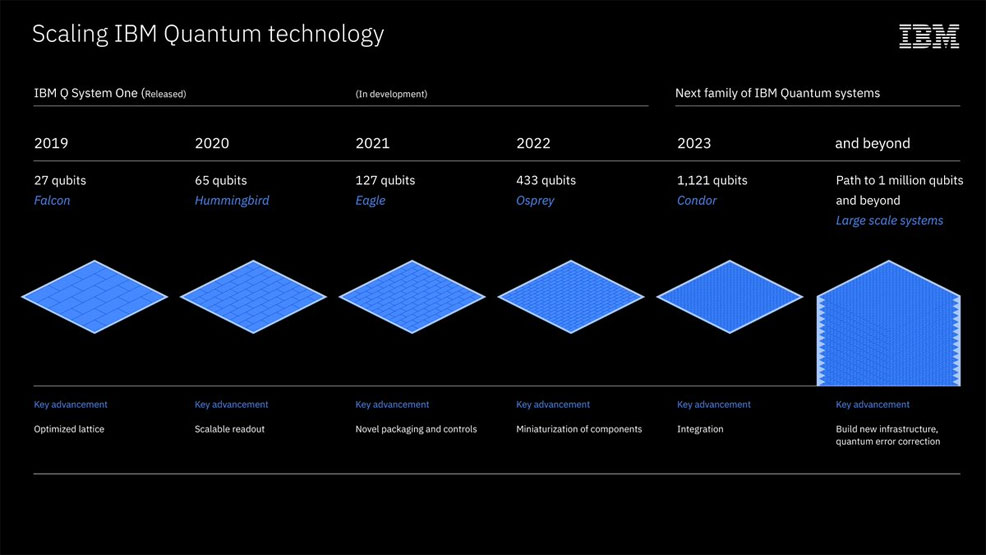
2023-2027
A tipping point for block chain
Bitcoin is a form of digital money that was created in 2009 by an unknown person. As a decentralised virtual currency, the system is peer-to-peer and transactions take place between users directly, without the need for banks or transaction fees.* These payments are verified by network nodes and recorded in a public distributed ledger called the “block chain”, which uses bitcoin as its unit of account. Although these records are public, the names of buyers and sellers are completely anonymous; only their wallet IDs are revealed. International payments are easy and cheap, since bitcoins are not tied to any specific country and are mostly unregulated.
New bitcoins are created as a reward for payment processing work in which users offer their computer processing power to verify and record payments into the public ledger. This activity is known as “mining” and miners are rewarded with transaction fees and newly created bitcoins. Besides being obtained by mining, bitcoins can be exchanged for other currencies, products, and services. Bitcoin became the first cryptocurrency – and by far the most well-known – but various others were introduced in subsequent years. These were frequently referred to as altcoins; a blend of bitcoin alternative.
The underlying block chain technology of these virtual currencies grew in popularity. Money was just one of their many possible applications. They could be programmed to represent units of energy, shares in a company, election votes, digital certificates of ownership, or whatever properties its users wished to assign. The open, transparent and flexible nature of cryptocurrencies helped to reduce bureaucracy, made administrative processes faster and more efficient and enabled the automation of many systems.
This became especially useful as the Internet of Things began to take shape. Machines could be programmed to automatically perform transactions and order new items or services when required, using the block chain for verification, without the need for banks or middle men. For example, a fridge or vending machine would know when its supplies were running low and ensure that food was kept regularly stocked.
In 2015, the number of merchants accepting bitcoin for products and services passed 100,000. Block chain was described as “one of the most powerful innovations in finance in 500 years” by the Wall Street Journal, with many banks predicting it could revolutionise their operations.* A tipping point for government use of the technology occurs by 2023, with large-scale adoption by businesses and the public by 2027.* Around 10% of the world’s gross domestic product (GDP) is stored on a block chain by this time, compared to just 0.025% in 2015. The supply growth is 25 bitcoins per block in 2016 (approximately every ten minutes), then afterwards 12.5 bitcoins per block for four years until the next halving. This halving continues until 2110–40, when 21 million bitcoins have been issued.*

2023
Croatia adopts the euro
On 1st January 2023, Croatia adopts the euro as its official currency,* becoming the 20th member state of the European Union (EU) to do so – and the first since Lithuania’s accession in 2015.
Croatia had joined the EU in 2013. Like other nations before it, becoming part of the single currency required five “convergence criteria” to be met, in order to demonstrate economic stability. These criteria placed limits on inflation, government budget deficits, debt-to-GDP ratios, and interest rates, for example.
The Croatian National Bank had originally planned for euro adoption within two or three years of EU entry. However, the European sovereign debt crisis and Croatia’s own contracting economy posed a challenge to its meeting of the convergence criteria, delaying its transition by several years.
As a precursor to full adoption of the euro, Croatia joined the EU’s exchange rate mechanism (ERM II) in July 2020. Later that year, Prime Minister Plenković stated that Croatia intended to adopt the euro on 1st January 2023. The government then published its action plan. In September 2021, Croatia signed an official agreement with the European Commission and eurozone member states on practical steps for the minting of Croation euro coins.
Having met the convergence criteria, Croatia transitions from the ERM II to the euro and phases out its national currency, the kuna. This new addition to the monetary union is followed by Bulgaria, which joins in 2024.
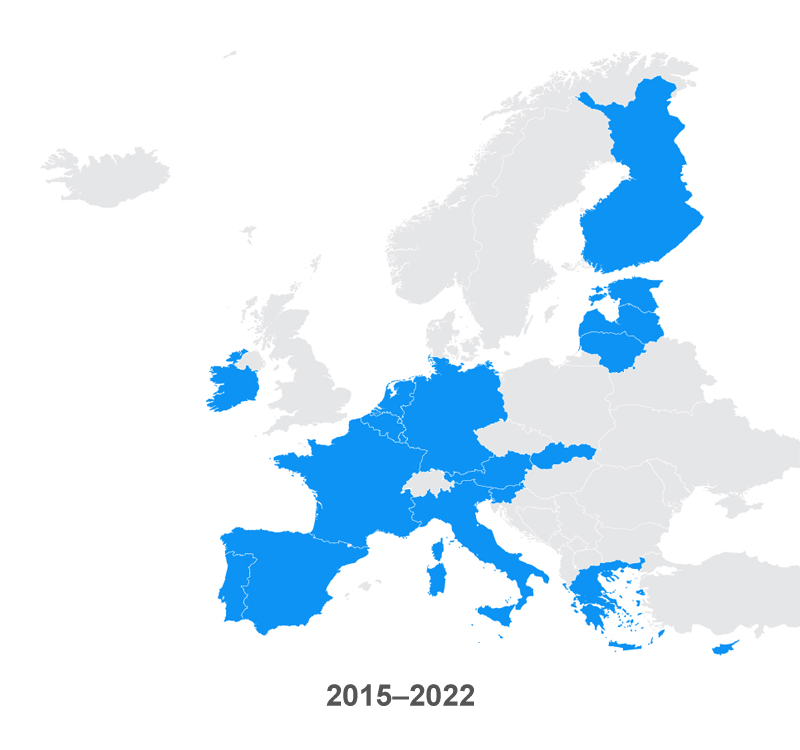
Xi Jinping extends his presidency
On 15th November 2012, Xi Jinping was elected as General Secretary of China’s Communist Party, replacing Hu Jintao. In his opening speech, he mentioned the aspirations of the average person, remarking, “Our people … expect better education, more stable jobs, better income, more reliable social security, medical care of a higher standard, more comfortable living conditions, and a more beautiful environment.”
Xi also vowed to root out corruption at the highest levels and warned that it could threaten the Party’s survival. This move subsequently led to the downfall of prominent Communist Party officials – including members of the Politburo Standing Committee, China’s highest decision-making body.
On 14th March 2013, Xi was elected President of the People’s Republic of China, in a confirmation vote by the 12th National People’s Congress, once again replacing Hu Jintao, who retired after serving two terms.
Xi introduced far-ranging measures to enforce party discipline and ensure unity. He significantly centralised institutional power by taking on a wide range of leadership positions – including chairing the newly formed National Security Commission. In addition to his anti-corruption campaign, he tightened restrictions over civil society and ideological discourse, advocating Internet censorship across China. He called for further socialist market economic reforms, for governing according to the law and for strengthening legal institutions, with an emphasis on individual and national aspirations under the slogan “Chinese Dream”.
Xi espoused a more assertive foreign policy, particularly with regard to China–Japan relations, China’s claims in the South China Sea, and its role as a leading advocate of free trade and globalisation. The 2015 meeting between Xi and Taiwanese President Ma Ying-jeou marked the first time the political leaders of both sides of the Taiwan Strait had met since the end of the Chinese Civil War in 1950.
In 2018, Forbes ranked Xi as the most powerful and influential person in the world, dethroning Russian President Vladimir Putin who held the accolade for five consecutive years. Viewed as one of the most important leaders in modern Chinese history, Xi amended the state constitution to abolish term limits, allowing him to continue serving as President beyond 2023.**
Among the major challenges facing China in the 2020s is a slowdown in population growth. The country had abandoned its one-child policy in 2015.* However, the relaxation of family planning laws did little to reverse this trend. Combined with rapid increases in life expectancy, China is therefore now experiencing the same problems that its rival, Japan, underwent in earlier decades. Substantial investments are being made for elderly care, along with measures to increase the economic productivity of its shrinking worker base.
To consolidate his power, President Xi takes advantage of the ongoing progress in artificial intelligence (AI), leading to a further crackdown on civil liberties as surveillance methods become ever more advanced. These and other technologies are also employed to great effect in foreign operations such as hacking, industrial espionage, spying and general cyber activities.
Other developments around this time include a further colonisation of islands in the South China Sea, plus additional pressure on Taiwan (though stopping short of all-out war) and progress on the Belt and Road Initiative.* China also continues to lead the global effort against climate change, with additional large-scale closures of coal-fired plants and a huge increase in clean energy capacity. By the middle of this decade, 50% of the country’s electricity is produced from renewable sources, more than twice the amount in 2015.
China continues its move away from being the world’s factory floor (cheap goods and low quality) to higher value products and services (e.g. aerospace, automotive, IT, pharmaceutical, robotics and semiconductors). Despite various economic, demographic and other challenges, it continues to edge ahead of the United States and to increase its share of global GDP.

India’s first crewed space flight
In 2023, India becomes only the fourth nation – after Russia, the US and China – to independently launch humans into space. The rocket used is a variant of the Geosynchronous Satellite Launch Vehicle, operated by the Indian Space Research Organisation (ISRO). This carries a largely autonomous 3.7-ton capsule with a three-person crew on board. They remain in orbit around the Earth at 248 miles (400 km) altitude for seven days, before splashing down in the Bay of Bengal. The total cost of the project is about 124 billion rupees ($2.67 billion). Originally planned for 2016, the mission faced delays, but is eventually launched in 2023.* Subsequent versions of the craft enable longer missions, including rendezvous and docking capabilities with space stations and other orbital platforms.
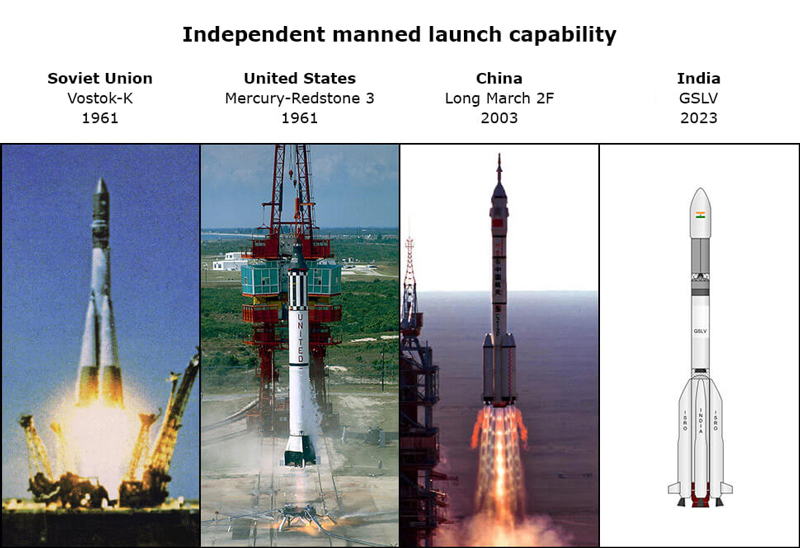
India GSLV image credit: WDGraham
Asteroid sample return mission
Origins Spectral Interpretation Resource Identification Security Regolith Explorer (OSIRIS-REx) is NASA’s first asteroid sample-return effort and only the second mission in history to retrieve samples from an asteroid.* Launched in 2016, it became the third selected mission in the New Frontiers Program, along with Juno and New Horizons.
The probe was sent to 101955 Bennu, a carbonaceous rock about 500m (1,640 ft) in diameter and classed as an Apollo asteroid. These are near-Earth asteroids whose orbits cross that of Earth. 101955 Bennu was calculated to have a small chance of colliding with Earth between the years 2169 and 2199,* making it of particular interest to study.
Equipped with a suite of instruments, including high resolution cameras, the probe arrived in 2018 and began imaging of the surface. Following a series of close orbital manoeuvres, a sample is gathered and returned to Earth in 2023. This reveals new insights about the formation and evolution of the early Solar System, initial stages of planet formation, and the source of organic compounds which led to the formation of life.* The total cost of the mission (including launch vehicle) is approximately $1 billion.

The Dark Ages Radio Explorer (DARE) is launched
The Dark Ages Radio Explorer (DARE) is a NASA spacecraft designed to investigate the early universe, between 80 million and 420 million years after the Big Bang. The observatory is placed in a lunar orbit, using the Moon’s shadow to hide from the Sun’s light and Earth’s radio interference. DARE is 25 feet (7.5 metres) across when its antennae are fully extended. The craft’s highly sensitive instruments can be used to measure redshifted emanations from primeval hydrogen atoms – revealing the moment when the first stars began to emit light.
In its early stages, the universe was opaque or “foggy”. Light existed, but invisible to modern telescopes. When photons were released (or decoupled), the universe became transparent. At this point, the only radiation emitted was the 21 cm spin line of neutral hydrogen. DARE uses this precisely redshifted 21 cm transition line from neutral hydrogen (40-120 MHz) to identify and view these first illuminations. This faint radiation is an even more powerful tool than the cosmic microwave background (CMB) for studying the early universe, giving a whole new perspective that earlier astronomy was unable to provide.*
In addition, DARE returns data on the earliest black hole accretions, the reionization of the universe, ancient galaxy formations and dark matter decay. The craft is operational from 2023.*
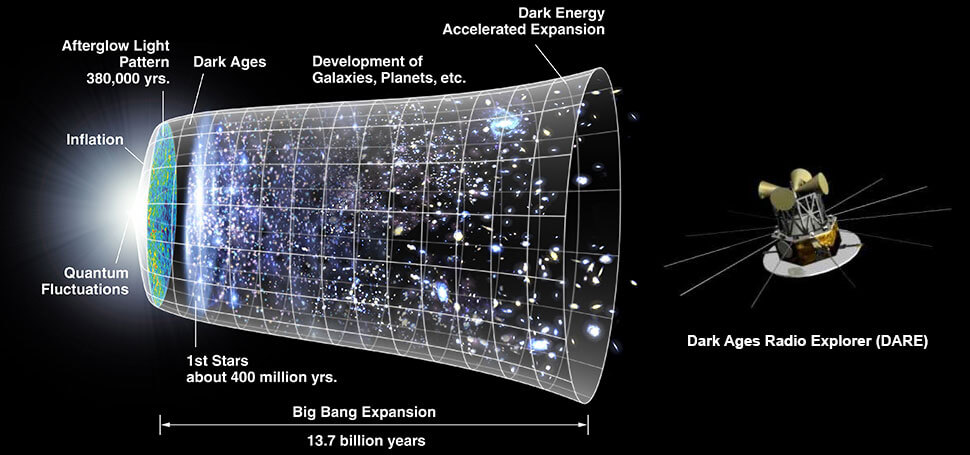
The Type 26 Global Combat Ship enters service
The Type 26 Global Combat Ship is a British Royal Navy vessel that replaces the aging Type 23 frigates. Following 25 years of research and development that began in 1998, it enters service in 2023,* with the programme running until the 2030s. A total of eight ships are constructed by BAE Systems during this time at a cost of nearly £12 billion ($16.5 billion). They remain in service until 2060.*
The Type 26 forms a general purpose fleet with air defence, anti-ship, towed array sonar and anti-submarine warfare capabilities. Each of these 150 m (492 ft) vessels has a crew complement of 118 (with capacity for 208), a top speed in excess of 26 knots (30 mph; 48 km/h), up to 8,000 tons of displacement when fully loaded, and a maximum range of 7,000 nautical miles (13,000 km). The ships are designed for multi-role versatility, flexibility in adapting to future needs, affordability in both construction and through-life support costs, and exportability.
The Type 26 features a number of improvements over its predecessor, the Type 23. It packs a formidable array of weaponry that includes strike length VLS silos enabling the ship to fire a mix of current and planned future missiles such as land attack missiles, very long range anti-ship missiles (far further than before) and anti-submarine missile torpedoes. Its missiles can target various air, sea and coastal threats – including speedboats, patrol boats, coastal batteries, helicopters and unmanned aerial vehicles (UAVs). The ship’s guns include a five inch BAE Mk 45 naval gun, two 30 mm DS30M Mk2 guns, two Phalanx CIWS weapon systems (for defence against anti-ship missiles) and a pair of miniguns, along with four general purpose machine guns.

Credit: BAE Systems
Being of greater size than its predecessor, the Type 26 has more aviation capacity and storage space. Its hangar can accommodate two helicopters (Royal Navy Wildcats and Merlins), while its flight deck supports a Chinook helicopter – a major improvement, which matches the Type 45 Destroyers’ Chinook-capable deck. The extra space enables a larger multi-role mission bay to hold more supplies, a mini hospital, disaster relief equipment and up to 60 Royal Marines, as well as mine hunting equipment.
If necessary, a fleet of these ships can be organised to have a group of 18 helicopters take off simultaneously and land more than 1,000 soldiers at a drop zone in a single movement. This brings massive force to bear immediately and makes full use of any element of surprise; a big improvement over previous fleet operational mission abilities.
Another notable feature of the Type 26 is an additional connected hangar and “flexible mission bay” at the aft end of the ship. This enables the ship to function as a base for launching small boats, as well as autonomous marine vehicles.
The Type 26 is designed with modularity and flexibility in mind to enhance versatility across the full range of operations, including maritime security, counter piracy, counter terrorist and humanitarian and disaster relief operations. The ship includes a Meteorological and Oceanographic (METOC) system, which collates and analyses environmental information to support operations.
Britain’s navy had already received a boost from the recent completion of the Queen Elizabeth-class aircraft carriers. The Type 26 Global Combat Ship is another highly important addition. By the 2030s, about half of the Royal Navy’s front line personnel are operating on these frigates. The modular design and open systems architecture ensure they can be easily upgraded as new technology develops.
Turkey
celebrates its 100th anniversary as an independent republic
Celebrations
are taking place this year to mark the centenary of the
*It bypasses the already existing Bosphorus Strait, substantially reducing congestion on the water and minimising the potential for collisions between oil tankers.* Excavated soil is used in the construction of a major new port, together with an airport, as well as the burying of defunct mines in the region.
Turkey has also achieved energy independence by now, with 10 billion barrels
of oil and over 1.5 trillion cubic metres of natural gas uncovered
in the Black Sea.* These huge
reserves have enabled the country to end its reliance on
foreign imports. Turkey’s standing in the world has increased significantly in recent years.* However, it has yet to be accepted into the European Union.*

Completion of the London “super sewer”
The Thames Tideway scheme is the biggest wastewater project in London since the mid-19th century. It involves a major upgrade of the aging Victorian system – helping to prevent discharge into the River Thames during periods of heavy rainfall and improving the overall quality of the city’s water. The storage-and-transfer tunnel is 35km long, with shafts 25m in diameter, 75m below ground for most of the route.* It runs across the city from west to east, then west again to a final pumping station.
Prior to the completion of this megaproject, some 32 million cubic metres of raw sewage was being discharged into the river each year. An overflow was occuring every week, even during moderate rainfall. By 2009, the situation had become so bad that the British government was threatened with legal action in the European Court of Justice.*
The Thames Tideway attracted controversy, however. Opponents raised concerns over the cost to Londoners (£4.1bn) and the impact of construction works on parks and house prices. Nevertheless, it goes ahead and is eventually finished by 2023.*
Brain implants to restore lost memories
By now, it’s becoming possible to replicate small areas of the brain with “neural prostheses” in order to repair damage from Alzheimer’s, stroke or injury. This includes the restoration of lost memories. These devices can mimic the electrochemical signals from regions like the hippocampus (involved in consolidation of information from short-term to long-term memory, as well as spatial navigation).
Experiments were initially conducted on rodents,* then monkeys,* before moving to human volunteers.* After years of clinical studies, the process can now be safely performed in hospitals. Electrode arrays are first used to record the activity of healthy brain tissue. The unique patterns responsible for creating memories are detected and stored by a computer. These patterns are then used to predict what the “downstream” damaged areas should be doing. Finally, the desired activity in healthy areas can be replicated by stimulating brain cells with electrodes. The neural prosthesis therefore bridges the gap from healthy to damaged areas.
A combination of these memory implants and drugs can treat early dementia and memory loss. In patients with advanced Alzheimer’s, however, the neural signals are usually too degraded for a successful outcome. Nevertheless, this new treatment is a significant step forward in understanding the brain. Eventually, it will be possible to mimic entire regions – bypassing the hippocampus, for example – with complex functions being replaced entirely by electrode signals. Further into the future, as neural implants continue to improve in power, this will pave the way for uploading of minds into computer substrates.*
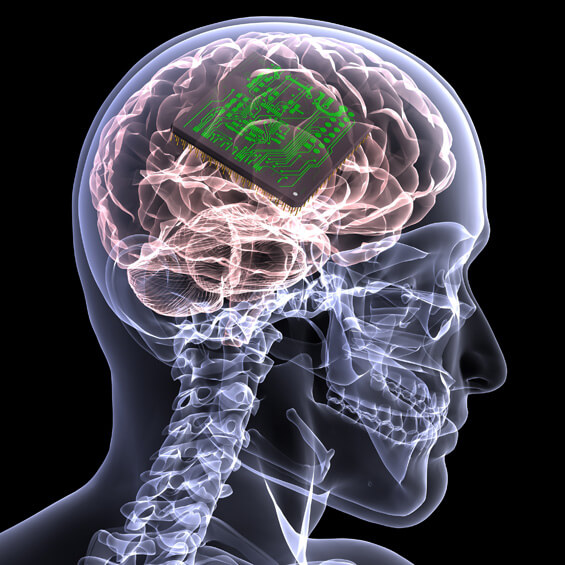
Canada’s first supertall skyscraper
This year sees completion of a major high-rise project in Toronto, the most populous city in Canada and fourth most populous in North America. The new building is a mixed-use tower named The One and becomes the first skyscraper in Canada to exceed 300 m (984 ft) in height, which is defined as “supertall” by the Council on Tall Buildings and Urban Habitat (the CN Tower, although taller, is technically considered an observation tower).
The One is part of a construction boom now underway in Toronto, which has more cranes than any other city in North America. Its completion follows the 2018 approval of TOcore – a 25-year plan for the city. This recognised the need for improved infrastructure – particularly residential buildings – to cope with rapidly increasing demand. As 130,000 people are welcomed to the region every year, the Greater Toronto Area is on track to see its population swell from 7 million to over 10 million by 2045.*
The One contains a mix of residential, retail and hotel properties. At 309 m (1,014 ft) and with 85 floors, it makes a significant mark on the skyline of Toronto and surpasses First Canadian Place, which had been Canada’s tallest building since 1976. The building has cutaways in mechanical floors to disrupt the flow of wind and prevent it blowing down to pedestrians at ground level, which had been a problem with tall buildings in the past. Another design feature is the use of giant exterior columns and diagonal beams, to transfer its weight and maximise the internal space.
The One is followed by an even taller building – the Pinnacle One Yonge, another mixed-use development that includes a 95-storey, 312 m (1,025 ft) tower and is completed in 2024. Many more skyscrapers are constructed in subsequent years and decades, as Toronto continues to attract an influx of new residents and begins to resemble Canada’s version of Manhattan.*
Click to enlarge

The One, Toronto. Credit: Mizrahi Developments
Driverless high-speed trains begin operating in France
In 2023, France begins rolling out high-speed, autonomous trains on its TGV network. The SNCF – France’s national state-owned railway company – began testing these “drone trains” in 2019. After four years of trials with a prototype, they are now ready for commercial use. The new trains are equipped with sensors to detect any potential hazards and automatically brake, if necessary. They can reach speeds of almost 200 mph (320 km/h) and their greater efficiency means that 25% more trains can be run on the same lines. While a number of slower trains had already been automated before, the SNCF becomes the first operator in the world to run automated high-speed trains.* Initially, conductors remain on board in case of an emergency.* The service runs between Paris and destinations to the southeast of France, but is gradually expanded to other parts of the country.

By Taxiarchos228 (Own work) [CC BY 3.0], via Wikimedia Commons
Completion of the Stad Ship Tunnel
The Stad Ship Tunnel is a 1.8 km (1.1 mile) canal and tunnel on Norway’s west coast, designed to allow ships to bypass the Stad peninsula – notorious for its hazardous weather and complex wave conditions. It is the world’s first tunnel for ships. The structure was first proposed in 1874, but not revived until more than 130 years later. Around eight million tons of rock is blasted out to build the tunnel, which is 50m high and 36m wide. This allows a water depth of 12 metres, sufficient to handle ships of up to 18,000 tons and large enough for the Hurtigruten coastal express ships to pass through. The overall project cost is 2.7 billion kroner ($314 million), with construction starting in 2019 and the official opening in 2023.*
VIPER mission to the lunar south pole
VIPER (Volatiles Investigating Polar Exploration Rover) is a NASA rover delivered to the surface of the Moon in late 2023.* It prospects for resources in permanently shadowed areas in the lunar south pole region, which includes mapping the distribution and concentration of water ice.
The vehicle – about the size of a golf cart – is equipped with a drill and three analysers. The Neutron Spectrometer System (NSS) can detect sub-surface water from a distance. VIPER then stops at that location and deploys a 1 m (3 ft 3 in) drill called TRIDENT to obtain samples, for more detailed analysis by a pair of onboard spectrometers.
The mission takes place over several kilometres, with data collected on different kinds of soil environments affected by light and temperature – those in complete darkness, occasional light, and in constant sunlight. Once it enters a permanently shadowed location, VIPER operates on battery power alone and is unable to recharge until it drives to a sunlit area. Its total operation time is approximately 100 Earth days.
The overall goal of VIPER is to identify the best locations for extracting water from the lunar south pole, in preparation for human missions. An extremely valuable resource in space, water has a number of vital uses – in life support systems, for example, and conversion into rocket propellant, when broken down into its constituent elements (hydrogen and oxygen).
Launch of China’s Xuntian space telescope
Xuntian (Chinese for “Space Sentinel”) is China’s first major space-based telescope. It has a 2 metre (6.6 foot) diameter primary mirror and a field of view that is 350 times larger than the Hubble Space Telescope, enabling it to image up to 40% of the sky at once, using a 2.5 gigapixel camera.
Xuntian is capable of studying a broad range of astronomical phenomena. In addition to delivering new insights about supermassive black holes, distant galaxies, dark matter, and dark energy, its various instruments can perform tasks such as mapping star-forming regions of the Milky Way, detecting fast-moving objects like comets and asteroids, and directly imaging exoplanets.
The telescope is placed in a co-orbital configuration with China’s space station in slightly different orbital phases, which allows for periodic docking with the station if repairs, maintenance or upgrades are needed. Launched in late 2023* on a Long March 5B rocket, it has an expected mission lifetime of 10 years.
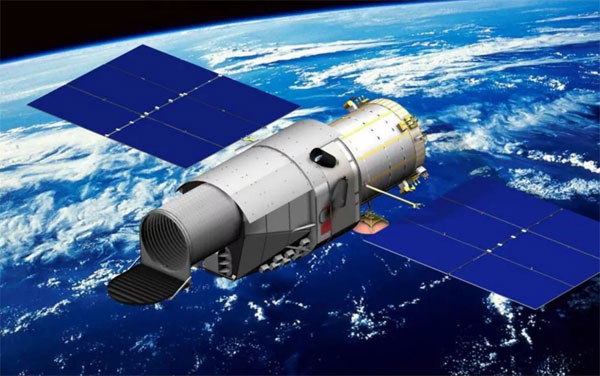
Credit: Jaimito130805, CC BY-SA 4.0, via Wikimedia Commons
The Vera C. Rubin Observatory begins full operations
Joining the various new telescopes deployed this year is yet another major observatory – the Vera C. Rubin Observatory (previously known as the Large Synoptic Survey Telescope). This achieves first light in February 2023, with full operations and a ten-year study beginning in December.* The facility is situated on the 2,715 m (8,907 ft) Cerro Pachón, a mountain in northern Chile.
The Vera C. Rubin Observatory is named after the late American astronomer who pioneered work on galaxy rotation rates and provided the first evidence for the existence of dark matter.
Its design is unique among large telescopes in having a very wide field of view: 3.5 degrees in diameter or 9.6 square degrees. For comparison, both the Sun and the Moon, as seen from the Earth, are 0.5 degrees across or 0.2 square degrees. Combined with its large aperture, this provides it with a spectacularly large collecting power of 319 m²degree². In other words, vast amounts of data can be obtained simultaneously over huge areas of sky.
The observatory has a 3.2 gigapixel camera, taking 200,000 pictures (1.28 petabytes uncompressed) per year, far more than can be reviewed by humans. Managing and effectively data mining this enormous output is among the most technically difficult parts of the project, requiring 100 teraflops of computing power and 15 petabytes of storage. The main scientific goals of the study include:
- Measuring weak gravitational lensing in the deep sky to detect signatures of dark energy and dark matter;
- Mapping small objects in the Solar System, particularly near-Earth asteroids and Kuiper belt objects;
- Detecting transient optical events such as novae and supernovae;
- Mapping the Milky Way.
Data from the telescope (up to 30 terabytes per night) is made available by Google as an up-to-date interactive night-sky map.
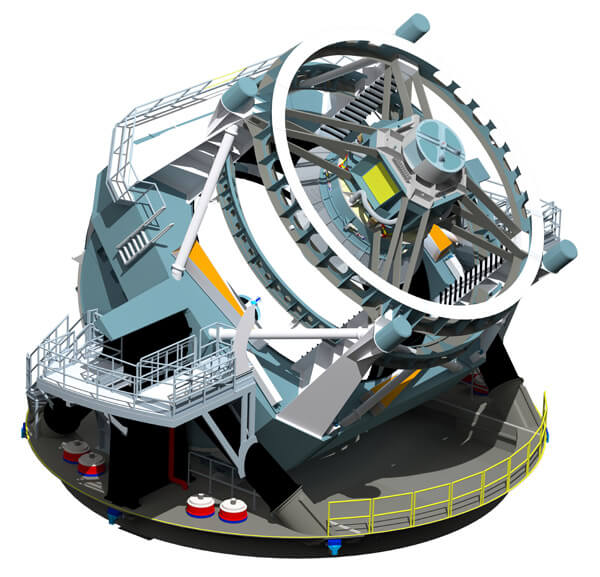
Credit: LSST Corporation
IBM debuts a 1,000+ qubit quantum computer
In 2023, IBM launches a new quantum computer known as Condor.* This features 1,121 qubits – the first machine by IBM to break the 1,000-qubit milestone and a 17-fold increase compared to its Hummingbird project of 2020.
With IBM’s researchers having overcome many of the earlier challenges in terms of scaling up, Condor represents an inflection point in the commercialisation of quantum technology. Another company, D-Wave Systems, had previously announced quantum computers featuring thousands of qubits. However, these relied on a technique called quantum annealing – with high error rates, and generally not accepted by researchers as true “universal” quantum computers. By contrast, IBM’s latest machine features extreme accuracy, with error rates having declined from 1% in 2020 to around 0.0001% in 2023.*
The new Condor processor can solve a range of problems, with more complex workloads than any existing chip. The project is used for exploring potential Quantum Advantages – calculations that work more efficiently on a quantum computer than on the world’s best supercomputers. This is made possible by a dilution refrigerator larger than any previously built, for supercooling the various components to near absolute zero. Condor‘s architecture – along with similar breakthroughs by rivals such as Google and Intel – paves the way for large-scale quantum systems with millions of qubits in the 2030s.
